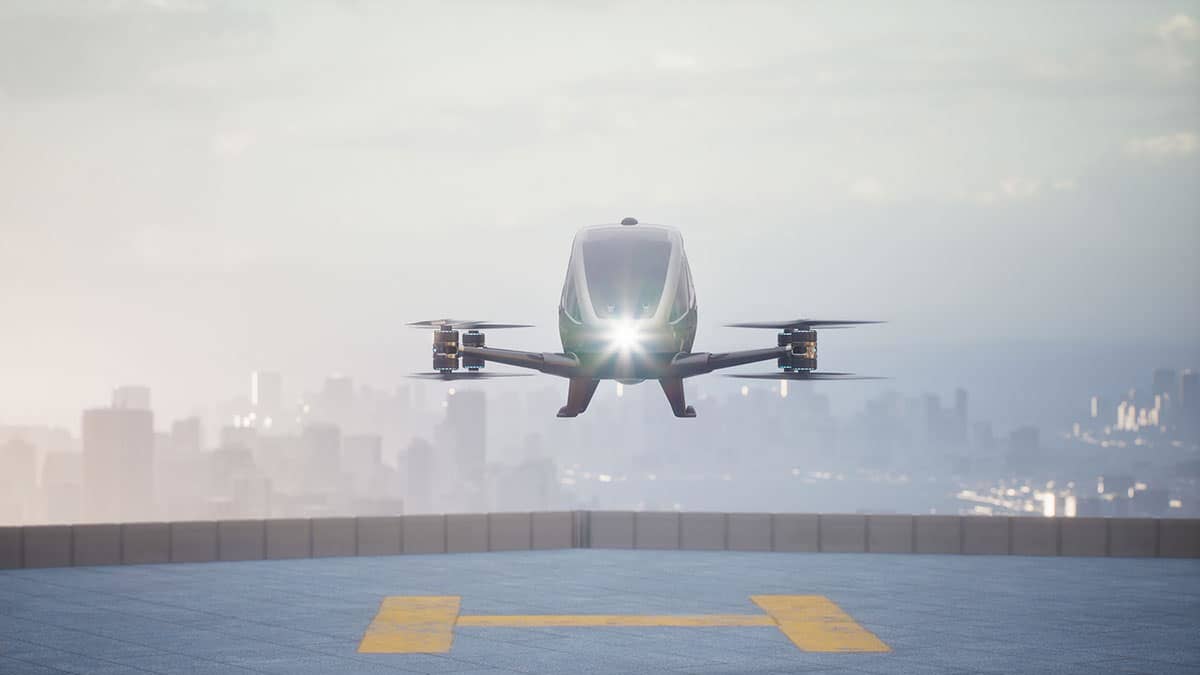Embry-Riddle Partners to Prepare Cities for Self-Flying Aircraft, Air Taxis
The country’s premier aviation and aerospace academy is working with the newly formed Advanced Air Mobility Association (AAMA) to create blueprints for integration.

Embry-Riddle faculty will provide its expertise around advanced air mobility (AAM) aircraft such as electric vertical takeoff and landing (eVTOL) air taxis. [Courtesy: Embry-Riddle Aeronautical University]
The United States’ premier aviation and aerospace academy is sharing its expertise to help usher in the era of advanced air mobility (AAM) aircraft, including drones, self-flying planes, and electric vertical takeoff and landing (eVTOL) air taxis.
Embry-Riddle Aeronautical University on Tuesday announced a partnership with the Advanced Air Mobility Association (AAMA), a nonprofit initiative working with the private sector, universities, government, and other stakeholders to create “road maps” for the introduction of AAM aircraft, tailored for major U.S. cities. Under the agreement, AAMA will leverage the expertise of Embry-Riddle faculty and provide students with opportunities for project collaboration, internships, and more.
AAMA was launched publicly in April and is led by president and CEO Antonio Campello, an Embraer executive of more than 30 years who most recently headed Embraer-X—the company’s innovation arm and technology incubator.
Johann Bordais, president and CEO of Embraer air taxi arm Eve Air Mobility, a spinoff of EmbraerX, sits on the group’s board, which also includes Bristow Group executive David Stepanek and Republic Airways executive Charles Hillis. Both Bristow and Republic are Eve partners.
In addition, AAMA adviser Frank Di Bello previously served as president and CEO of Space Florida, an Eve investor. Michael Amalfitano, who sits on Eve’s board, is on Embry-Riddle’s board of trustees.
However, Campello told FLYING that AAMA receives no funding from Embraer or Eve and is fully agnostic, working with all platforms and OEMs and favoring no company. He said the group has been inviting AAM operators, aircraft manufacturers, industry groups, universities, and city governments to help build the ecosystem needed to bolster a new wave of transportation.
Passenger- or cargo-carrying electric air taxis, for example, will require vertiports, special takeoff and landing sites fitted with chargers and other equipment. Designing, building, operating, and regulating these sites will be a collaborative effort.
AAMA intends to establish “readiness laboratories,” where stakeholders can create and implement a minimum viable product (MVP). Businesses use MVPs, which typically are designed with just enough features to be usable for early customers, to gauge the feasibility of an idea. Essentially, the group is looking to launch a beta version of an AAM ecosystem and receive feedback from customers on how it could be improved.
AAMA will use funding generated from membership fees, grants, events, and fees charged to use its readiness labs to create reports describing how different regions can integrate air taxis and other novel aircraft. Per a pitch deck viewed by FLYING, it will also advocate for key regulations on Capitol Hill.
According to Embry-Riddle, AAMA will work with university faculty that lead AAM programs, such as within the Eagle Flight Research Center. Kyle Collins, an assistant professor of aerospace engineering and the director of the center, said it has been exploring the topic for years.
Embry-Riddle students will also be able to work directly with AAMA members on projects and will have opportunities to intern with the association and its member organizations.
“We’re excited to see our team of experienced professionals collaborating with researchers, faculty, and students to propose innovative and customized solutions aimed at implementing a safe and efficient advanced air mobility ecosystem in cities and regions across the globe,” said Campello.
Separately, Embry-Riddle is collaborating with the Greater Orlando Aviation Authority (GOAA), which manages Orlando International Airport (KMCO), to explore the integration of AAM operations at that site. In addition, researchers are working under a $1.4 million NASA grant to study how air taxis can take off quietly and safely in dense urban environments and turbulent conditions.
It’s unclear how much access AAMA will be granted to those projects, but the organization will hope to glean insights from top aviation experts.
Like this story? We think you'll also like the Future of FLYING newsletter sent every Thursday afternoon. Sign up now.

Sign-up for newsletters & special offers!
Get the latest FLYING stories & special offers delivered directly to your inbox






